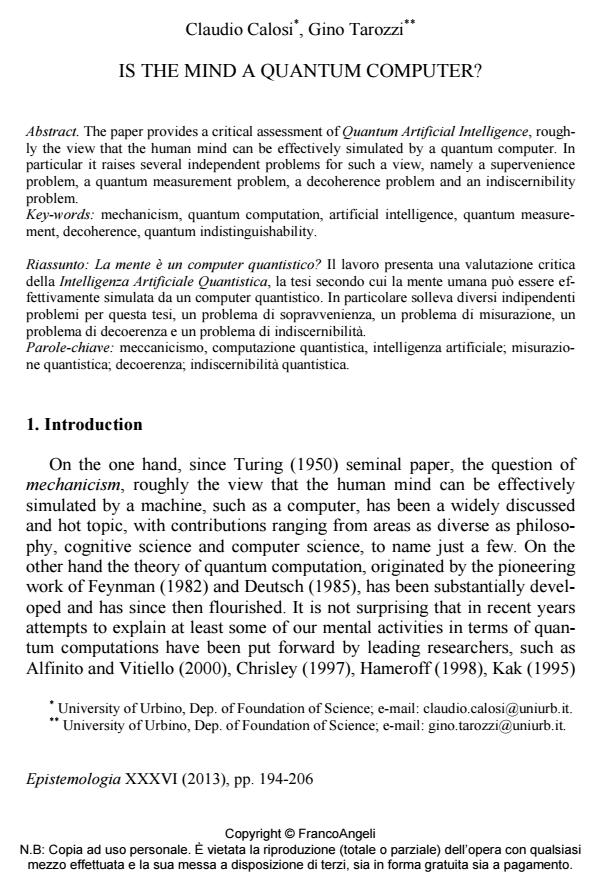Is the mind a quantum computer?
Titolo Rivista EPISTEMOLOGIA
Autori/Curatori Claudio Calosi
Anno di pubblicazione 2014 Fascicolo 2013/2 Lingua Inglese
Numero pagine 13 P. 194-206 Dimensione file 620 KB
DOI 10.3280/EPIS2013-002002
Il DOI è il codice a barre della proprietà intellettuale: per saperne di più
clicca qui
Qui sotto puoi vedere in anteprima la prima pagina di questo articolo.
Se questo articolo ti interessa, lo puoi acquistare (e scaricare in formato pdf) seguendo le facili indicazioni per acquistare il download credit. Acquista Download Credits per scaricare questo Articolo in formato PDF

FrancoAngeli è membro della Publishers International Linking Association, Inc (PILA)associazione indipendente e non profit per facilitare (attraverso i servizi tecnologici implementati da CrossRef.org) l’accesso degli studiosi ai contenuti digitali nelle pubblicazioni professionali e scientifiche
The paper provides a critical assessment of Quantum Artificial Intelligence, roughly the view that the human mind can be effectively simulated by a quantum computer. In particular it raises several independent problems for such a view, namely a supervenience problem, a quantum measurement problem, a decoherence problem and an indiscernibility problem.
Il lavoro presenta una valutazione critica della Intelligenza Artificiale Quantistica, la tesi secondo cui la mente umana puo essere effettivamente simulata da un computer quantistico. In particolare solleva diversi indipendenti problemi per questa tesi, un problema di sopravvenienza, un problema di misurazione, un problema di decoerenza e un problema di indiscernibilita.
Keywords:Meccanicismo, computazione quantistica, intelligenza artificiale; misurazione quantistica; decoerenza; indiscernibilita quantistica.
- Albert D., Loewer B. (1988). Interpreting the many worlds interpretation, Synthese, 77, pp. 195-213.
- Alfinito E., Vitiello G. (2000). The dissipative quantum model of the brain: how does memory localize in correlated neural domains, Information Sciences, 128, pp. 217-229.
- Bacciagaluppi G. (2012). The role of decoherence in quantum mechanics, http://plato.stanfordedu/entries/qm-decoherence/ [Accessed: 21/11/2012]. Barrett J.A. (1999). The quantum mechanics of minds and worlds, Oxford, Oxford University Press.
- Calosi C., Fano V. (2012). A threat for physicalism. A new gedankenexperiment, Epistemologia, 25, pp. 130-140.
- Chrisley R. (1997). Learning in non-superpositional quantum neurocomputers. In Pylkkanen P., Pylkko P. (eds.), Brain, mind and physics, Amsterdam, IOS Press, pp. 126-139.
- Deutsch D. (1985). Quantum theory, the Church-Turing principle and the universal quantum computer, Proceedings of the Royal Society of London A, 400, pp. 97-117.
- Eliasmith C. (2001). Attractive and in-discrete: a critique of two putative virtues of the dynamicist theory of mind, Minds and Machines, 11, pp. 417-425.
- Feynman R.P. (1982). Simulating physics with computers, International Journal of Theoretical Physics, 21, pp. 467-488.
- Garuccio A., Rapisarda V., Vigier J.P. (1982). New experimental set-up for the detection of De Broglie waves, Physical Letters A, 90 (1-2), pp. 17-19.
- Ghirardi G.C., Rimini A., Weber T. (1986). Unified dynamics for microscopic and macroscopic systems, Physical Review D, 34, pp. 470.
- Hameroff S. (1998). Quantum computation in brain microtubules? The Penrose-Hameroff “Orch OR” model of consciousness, Philosophical Transactions of the Royal Society of London A, 356, pp. 1869-1896.
- Hameroff S. (2006). Consciousness, neurobiology and quantum mechanics- The case for a connection. In Tuszynski J. (ed.), The emerging physics of consciousness, Berlin, Springer, pp. 193-253.
- Hameroff S. (2007). The brain is both neurocomputer and quantum computer, Cognitive Science, 31, pp. 1035-1045.
- Hameroff S., Penrose R. (1996a). Conscious events as orchestrated spacetime selections, Journal of Consciousness Studies, 3, pp. 36-53.
- Hameroff S., Penrose R. (1996b). Orchestrated reduction of quantum coherence in brain microtubules: A model for consciousness. In Hameroff S., Kaszniak A.W., Scott A.C.
- (eds.), Towards a Science of Consciousness II: the second Tucson discussions and debates, Cambridge (Mass.), MIT Press, pp. 507-540.
- Kak S. (1995). Quantum neural computing, Advances in imaging and electron physics, 94, pp. 259-313.
- Litt A., Eliasmith C., Kroon F., Weinstein S., Thagard P. (2006). Is the brain a quantum computer?, Cognitive Science, 30, pp. 593-603.
- Pearl P. (1998). True collapse and false collapse. In Feng H., Hu B.L. (eds.), Quantum classical correspondence, Cambridge, International Press, pp. 51-68.
- Penrose R. (1994). Shadows of the mind, Oxford, Oxford University Press.
- Penrose R. (1996). On gravity’s role in quantum state reduction, General Relativity and Gravitation, 28, pp. 581-600.
- Penrose R., Hameroff S. (1995), What gaps? Reply to Grush and Churchland, Journal of Consciousness Study, 2, pp. 98-112.
- Tarozzi G. (1996). Quantum measurements and macrophysical reality: epistemological implications of a proposed paradox, Foundations of Physics, 26, pp. 907-917.
- Tegmark M. (2000). Importance of quantum decoherence in brain process, Physical Review E 61, pp. 4194-4206.
- Turing A.M. (1950). Computing machinery and intelligence, Mind, 59, pp. 433-460.
Claudio Calosi, Is the mind a quantum computer? in "EPISTEMOLOGIA" 2/2013, pp 194-206, DOI: 10.3280/EPIS2013-002002